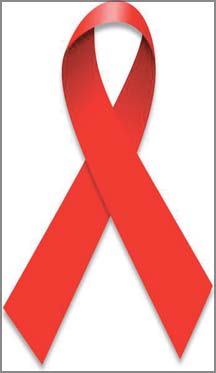Health Watch
World AIDS Day:
Sri Lanka ahead in combating
HIV/AIDS
Nadira Gunatilleke
Tomorrow is World AIDS Day. The whole world marks this day with
various ceremonies and programs. Sri Lankans have many things to be
proud of when it comes to combating HIV/AIDS. The main factor is Sri
Lanka’s significantly low HIV/AIDS prevalence rate (less than 0.1) which
is one of the lowest in the whole world since a long time. There are
certain factors we have to take care of in order to maintain our proud
status and there are certain internal and external forces that hate our
extremely low HIV/AIDS prevalence rate. Therefore we have to be vigilant
and active when it comes to maintaining this low prevalence rate.
According to Healthcare and Nutrition Minister Nimal Siripala de
Silva, Social Services and Social Welfare Deputy Minister Lionel
Premasiri, doctors, teachers and the general public, it is Sri Lanka’s
rich cultural heritage and religions that protect the Sri Lankan society
from HIV/AIDS.
|

Stigma should be battled. Reuters |
They say that Sri Lankan culture never encourage people to engage in
risky sexual practices and always encourage them to protect themselves
and their loved ones.
It is same with all the religions in Sri Lanka. The culture and all
religions encourage Sri Lankans to be faithful to themselves and to
their spouses. But this is not so when it comes to many other non Asian
countries.
What we should be concerned in order to maintain our low HIV/AIDS
prevalence rate? This is the main factor Sri Lanka should be focused on
at the moment. Although we are ready to accept or not, there are certain
groups of persons such as migrant workers, drug addicts (who use needles
to inject drugs), commercial sex workers, MSM (Men having sex with Men),
LGBT ( Lesbians, Gays, Bisexuals and Trans Gender persons) in our
society.
The percentage of such persons is very low. Majority of them live
invisibly while some powerful LGBT persons live openly. But all of them
face the same risk when it comes to health and HIV/AIDS.
When they visit health institutions, the authorities should make sure
that they receive the best health care service plus education without
discrimination. This is the only way of minimizing the spread of HIV.
These specific groups of persons face an additional risk because of
their risky sexual behaviour.
|

Towards an AIDS free world |
It is well known fact that commercial sex workers are at a greater
risk and they need to wear condoms. But sometimes their clients do not
allow them to wear condoms.
Another well known fact is that the majority of MSM do not wear
condoms for various reasons. LGBT persons face the same problem often.
Special attention should be paid to encourage above groups of persons
to use condoms all the time and come forward and get themselves tested
for HIV. So far the majority of HIV/AIDS awareness raising programs were
not focused on them. It is some extra work for the NGOs to find out
strategies and approach them, but it should be done no matter how hard
and expensive it is. No point of educating the same target groups all
the time.
What are the internal and external forces that have desire and power
to increase our low HIV/AIDS prevalence rate? You may not believe what
some (not all) Non Governmental Organisations (NGOs) do in connection
with HIV/AIDS. Some of them are only interested in the flow of funds.
What matters most is the hilarious attitudes of some persons who hold
positions of such NGOs. But the bitter truth is low HIV/AIDS prevalence
rate means less funds and donations for the NGOs and high HIV/AIDS
prevalence rate means a lot of funds and donations for them. Here anyone
can suspect the real intentions of some NGOs.
Some NGOS work hard utilising their funds very effectively on
controlling HIV/AIDS while some NGOs do just the opposite. Sometimes one
can suspect weather some NGOs working on preventing HIV/AIDS or
promoting it because of their suspicious behaviours and strange
approaches towards the issue.
Even mentioning about culture and religions is poisonous for them.
They laugh at our rich cultural heritage and religions. They faint when
a news item appears on a national newspaper stating that culture and
religions make a significant contribution towards preventing HIV/AIDS
and even call the journalist to express their protest against such a
news item! The behaviour of external forces is not surprising at all.
Everything comes in the ‘goodwill’ wrapper. No one suspect about
anything and no sign of a plan B or a hidden agenda. But we can hear
certain words such as low condom use, suppression of women, low literacy
rate, resistance etc all the time.
As watch dogs of the society it is our duty to tell the public the
true situation that exist in the country. It is your duty to take care
of yourself and your loved ones. It is our duty to protect our culture
and religions which take care of Mother Lanka. It is very easy because
we are still in the very early stage of the disaster. We have a stronger
weapon than any other country in the world to fight against HIV/AIDS. It
is our culture and religions. Our literacy rate is over 90 percent. We
do not have a heavy work load. The only thing we have to do is living
our lives as real Sri Lankans.
New HIV infections down by 17 percent
Most progress seen in sub-Saharan Africa:
According to new data in the 2009 AIDS epidemic update, new HIV
infections have been reduced by 17 percent over the past eight years.
Since 2001, when the United Nations Declaration of Commitment on
HIV/AIDS was signed, the number of new infections in sub-Saharan Africa
is approximately 15 percent lower, which is about 400,000 fewer
infections in 2008. In East Asia HIV incidence has declined by nearly 25
percent and in South and South East Asia by 10 percent in the same time
period.
|

Drop in AIDS infections, a reason to smile. Reuters |
In Eastern Europe, after a dramatic increase in new infections among
injecting drug users, the epidemic has levelled off considerably.
However, in some countries there are signs that HIV incidence is rising
again.
The report, released by the Joint United Nations Program on HIV/AIDS
(UNAIDS) and the World Health Organization (WHO), highlights that beyond
the peak and natural course of the epidemic - HIV prevention programs
are making a difference.
“The good news is that we have evidence that the declines we are
seeing are due, at least in part, to HIV prevention,” said Michel Sidib‚,
Executive Director of UNAIDS. “However, the findings also show that
prevention programming is often off the mark and that if we do a better
job of getting resources and programs to where they will make most
impact, quicker progress can be made and more lives saved.”
Changing approach
In this first double issue, the UNAIDS Outlook report further
explores how ‘modes of transmission’ studies are changing the approach
of HIV prevention efforts. The new magazine-style report looks at new
ideas and ways to use the data collected in the companion
epidemiological report.
Data from the AIDS Epidemic Update also show that at 33.4 million,
(31.1 million - 35.8 million) there are more people living with HIV than
ever before as people are living longer due to the beneficial effects of
antiretroviral therapy and population growth. However the number of
AIDS-related deaths has declined by over 10 percent over the past five
years as more people gained to access to the life saving treatment.
UNAIDS and WHO estimate that since the availability of effective
treatment in 1996, some 2.9 million lives have been saved.
Concrete results
Dr. Margaret Chan, Director-General of WHO said, “International and
national investment in HIV treatment scale-up has yielded concrete and
measurable results. We cannot let this momentum wane. Now is the time to
redouble our efforts, and save many more lives.” Antiretroviral therapy
has also made a significant impact in preventing new infections in
children as more HIV- positive mothers gain access to treatment
preventing them from transmitting the virus to their children. Around
200,000 new infections among children have been prevented since 2001.
In Botswana, where treatment coverage is 80 percent, AIDS-related
deaths have fallen by over 50 percent over the past five years and the
number of children newly orphaned is also coming down as parents are
living longer.
Courtesy:WHO
Re-cultivating the rice culture - a response:
Factors that lead to diabetes
Dr. Nishan Sudheera Kalupahana
I read the article entitled ‘Re-cultivating the rice culture’ in
Health Watch on November 16, 2009 and wanted to add the following with
regards to causes of diabetes. While it is possible that the increase in
prevalence of diabetes in Sri Lanka is partly due to the shift of food
culture from rice to flour as Dr. Siribaddana pointed out, the following
factors also likely play a major role in this.
Abdominal obesity
Individuals with a higher amount of abdominal fat are at a higher
risk of developing diabetes. It is now established that fat cells
produce chemical messengers called adipokines which are affected when
too much fat is stored in these cells as occurring in obesity.
|

Obesity, a major cause for diabetese |
Asian populations are especially prone to the development of
abdominal obesity.
Weight loss leading to a reduced waist line will lower the risk of
getting diabetes drastically. Cutting down the amount you eat,
exercising more and monitoring your weight would help in losing weight.
Lack of physical activity
Due to lifestyle changes in the last few decades, people have become
less physically active.
This is another risk factor for diabetes. Engaging in
moderate-intensity exercise (e.g. brisk walking) for at least 30 minutes
every day would reduce the risk of getting diabetes.
Increased intake of saturated and trans-fats
Research has shown that the intake of saturated and trans-fats are
associated with an increased risk of developing diabetes. Foods that
contain trans-fats are hydrogenated oils such as solid margarines.
Examples for saturated fats containing foods are full-cream milk,
coconut oil and milk and animal fat. A shift from the above foods to
whole-grains, low-fat dairy and poultry and vegetables and grains cooked
without adding coconut milk (mirisata instead of kirata) will therefore
reduce the risk of diabetes.
The writer is attached to the Faculty of Medicine, Peradeniya and the
University of Tennessee Obesity Research Center, USA
Health News Summary
More than 1,000 deaths in past week from H1N1: WHO:
More than 1,000 deaths from the H1N1 swine flu virus were officially
reported in the past week, a sharp rise which brings the global total to
at least 7,826, the World Health Organization (WHO) said on Friday.
Kids should get moving to avoid obesity
NEW YORK - Vigorous exercise may be an especially good way to keep
kids lean, but sitting around, in and of itself, doesn’t appear to have
a major role in making them fat, new research shows.
Nevertheless, there are still plenty of reasons to avoid too much
sedentary “screen time,” Dr. Ulf Ekelund of the MRC Epidemiology Unit in
Cambridge, UK and colleagues say, given potential negatives including
“violence and aggressive behavior, poor academic performance, and poor
body image.”
Detergent exposure hard on workers’ lungs
NEW YORK - People who work in detergent factories are at
increased risk of developing respiratory problems, including asthma,
probably from exposure to chemicals contained indetergent, two new
studies hint.
But a spokesman for the detergent industry argues that the findings
from these studies don’t apply to the US and European detergent
industries at large.
“Over the years, the detergent industry has developed successful
product stewardship programs to promote the safe use of enzymes, using
appropriate risk assessment and risk management strategies to avoid
unacceptable risks in the workplace,” Richard Sedlak, vice president of
technical and internal affairs for The Soap and Detergent Association (SDA),
said in a prepared statement.
Dementia big threat for elderly in poorer nations
LONDON - Dementia is the biggest cause of disability in old people in
poorer countries.
British researchers studied 15,000 elderly people in seven low- and
middle-income countries and found that, contrary to previous expert
opinion, dementia, not blindness, is by far the biggest cause of poor
health in old age.
Many pregnant women take drugs harmful to baby
NEW YORK - With the help of their doctors, women planning to become
pregnant should take an inventory of the medications they take,
researchers from Canada advise. In a study, they found that many
pregnant women still take medications long known to cause birth defects.
REUTERS
|



